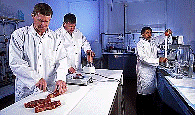United States Department of Agriculture: Agricultural Research Service, Lincoln, Nebraska

Roman L. Hruska U.S. Meat Animal Research Center: Reports
Date of this Version
1985
Document Type
Article
Abstract
Castration of the male in meat-producing animals has long been a traditional practice in the production of commercial livestock. Numerous research studies have indicated that intact bovine males grow more rapidly, utilize feed more efficiently, and produce a higher yielding carcass than castrates. Even though young bulls have obvious growth and leanness advantages over steers, their meat is usually lower and more variable in tenderness than steers. These differences in tenderness have been attributed to differences in fatness or differences in connective tissue.
Factors influencing the amount and strength of intramuscular collagen have been linked to animal age, sex, and breed. The literature strongly indicates that collagen solubility decreases significantly with animal age and that most of these changes take place from birth to about 2 years of age. Results have illustrated that the age-related changes in tenderness are significantly more pronounced in bulls than in steers and heifers, particularly in muscles high in collagen. These findings suggest that age-related changes in the cross-linking of collagen might be related to the sex of the animals.
Several workers reported an increase in collagen content in young bulls at about 12 months of age. Others have suggested that the increase in collagen content at this age, which was accompanied by an increased solubility, was due to an increase in collagen synthesis related to the hormonal changes occurring during puberty in young bulls.
The objective of this phase of our research was to investigate the influence of animal age, breed, and sex condition (bull vs steer) on the content and solubility of intramuscular collagen using muscle biopsies in the longissimus muscle.


Comments
Published in Beef Research Program Progress Report (1985) No. 2: 63-64